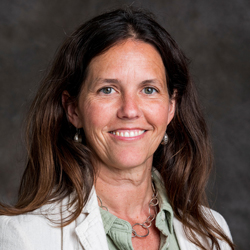
Laurie Baise has continuously worked at the interface of earthquake science starting with her academic preparation. She received an undergraduate degree in civil engineering with a certificate in geological engineering and she completed graduate Master of Science degrees in both geophysics and geotechnical engineering while pursuing her Ph.D. in civil engineering. Baise’s research has spanned earthquake site response, liquefaction, site characterization, regional wave propagation, ground motions models and earthquake damage assessment. Like Joyner, she blends the practical needs of earthquake engineering with the breadth of understanding across earthquake science. She uses data-driven approaches to learn from observational data and was an early adopter of machine learning methods in model development.
In site response, her focus has been on understanding the origin of complexity in site response through the study of observational data and using weak ground motion and microtremor data for site characterization. In the area of regional mapping of seismic hazards, Baise’s work has focused on developing regional seismic hazard maps that optimally use multiple sources of geo-data across different resolutions and exploring alternate interpolation strategies.
Baise’s research contributions at the interface of seismology and earthquake engineering include a new approach for predicting liquefaction extent after earthquakes, called geospatial liquefaction modeling. The approach has fundamentally advanced the mapping of liquefaction risk across broad geographical regions. Her work inspired an analogous model for landslides, and the two models are now integrated into the U.S. Geological Survey’s earthquake monitoring systems and by hazard modelers in the insurance industry. She is currently working on comparable geospatial models for site amplification for use in ground motion models and the National Seismic Hazard Maps.
Baise’s interest in regional seismic hazard efforts stemmed from her work in the northeastern United States, where she has documented liquefaction and ground-shaking potential throughout New England. Her work as president and founding member of the New England Chapter of EERI and her development of the first earthquake engineering research group at Tufts brought renewed attention to a region where earthquake hazards are often unappreciated. Her work in New England has highlighted the unique characteristics of soil amplification in glaciated terrains and the importance of models that can be adapted to different regional contexts.
Along with her leadership at EERI, Baise served twice on the SSA Board of Directors from 2011 to 2014 and 2014 to 2017. She was an associate editor at the Bulletin of the Seismological Society of America from 2013 to 2016. Baise has been honored by numerous awards including the ASCE Casagrande Award in 2008 and the NSF CAREER Award in 2006 and both graduate and undergraduate teaching and mentoring awards at Tufts University. She has also served as the department chair for the department of civil and environmental engineering at Tufts since 2017.
Although she never had the opportunity to meet Bill Joyner, he was an early role model for her as she launched her career in earthquake science and earthquake engineering, she said.
In her nomination and support for the award, Baise’s colleagues noted her focus on the early adoption and development of new techniques at the interface of earthquake science and engineering, including machine learning methods and satellite imagery. Past Joyner Lecturers cited her leadership in urging researchers and engineers to consider more complex and realistic site response models. They also noted that Baise’s expansive career has been an inspiration to students pursuing multidisciplinary degrees who have gone on to careers in government, industry and academia.
